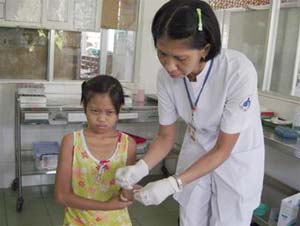Sudden increase in thirst, appetite, frequent urination, and weight loss can be signs that a child has diabetes. In the South, children often suffer from type 1 diabetes, while in the North, there have been cases of type 2 diabetes – a form of the disease commonly found in obese adults.
Any Age Can Be Affected
 |
| Patient Phan Thi Thanh Hai has had diabetes for 11 years (Photo: L.TH.H) |
In mid-April, at the Nephrology Department of Children’s Hospital 1 in Ho Chi Minh City, three children diagnosed with type 1 diabetes were undergoing treatment. Patient Phan Thi Thanh Hai (born 1992, Binh Duong) has battled the disease for 11 years and, due to inconsistent treatment, is now at a stage with complications. She is small and frail, resembling a 7-8-year-old child. Every 10-15 minutes, she needs to use the toilet.
Her younger sister, Phan Thi Thanh Hong (born 1996), is also managing diabetes while receiving treatment at home. The department is currently treating two newly diagnosed patients who were admitted at the beginning of April. The parents of these children report that when the disease first appeared, the children suddenly ate excessively, as if they were “possessed,” constantly requested water, and urinated around 15-20 times a day.
Dr. Nguyen Thi Thuy An stated that diabetes is a metabolic disorder that includes two types: type 2 diabetes, which is insulin-independent and characterized by insulin resistance, commonly seen in obese adults with lipid disorders or vascular diseases, and is rarely encountered in children. The type seen in children is type 1 diabetes, which is insulin-dependent.
Approximately 50% of children with type 1 diabetes develop it before the age of 20. The disease can occur at any age, but the peak onset typically occurs around ages 5-7 or during puberty. The incidence of type 1 diabetes in children is on the rise. In 2004, the Nephrology Department admitted 25 patients for treatment, which increased to 38 in 2005. Currently, the department is managing treatment for 58 patients who return for regular check-ups.
When the disease initially manifests, children often experience excessive thirst and frequent urination throughout the day, gradually losing weight and feeling fatigued. Many children suddenly wet the bed or have a need to urinate multiple times during the night. Blood tests will typically reveal elevated blood sugar levels and the presence of sugar in urine. Some patients may experience a more rapid progression of the disease, accompanied by complications due to infections or injuries in the body…
At this point, children may experience abdominal pain, vomiting, and signs of dehydration ranging from mild to severe. In severe cases, they can suffer from cardiovascular collapse, respiratory disturbances, and have breath that smells of acetone. Without timely treatment, this can lead to coma and even death. Occasionally, symptoms may manifest as chronic complications such as susceptibility to infections, fungal infections, slow-healing wounds, or cataracts.
Patience in Treatment
According to Dr. Thuy An, although modern medicine has not yet completely cured type 1 diabetes, if blood sugar levels are managed effectively, patients can still engage in daily activities, study, or participate in sports. However, without proper monitoring and control, complications are likely to arise: retinal disease, proteinuria leading to gradual kidney damage, hypertension, lipid disorders, vascular diseases, and neuropathy.
Depending on the duration of the disease, doctors will recommend eye examinations, urine tests, ECGs, and blood lipid tests to detect and monitor complications. Patients should not skip treatment and must adhere to their doctor’s instructions, regularly monitoring blood sugar levels at home. It is advisable to check blood sugar more frequently when the child is ill to prevent severe complications.
Dr. Nguyen Thi Hoa, head of the Nutrition Department at Children’s Hospital 1, mentioned that obesity in children is also on the rise. In addition to current complications, obese children are likely to become obese adults with all associated complications. At Children’s Hospital 1, there were 786 visits for obesity in 2000, which rose to 2,202 visits last year. Many studies show that type 2 diabetes in children is increasing in tandem with obesity.
Some studies conducted both domestically and internationally indicate that obese children have higher insulin levels than normal-weight children. This means that as they reach adulthood, they face a higher risk of developing type 2 diabetes. A study of 330 children with obesity treated at Children’s Hospital 1 showed that 18.3% of patients had blood sugar disorders, with 12.2% of children exhibiting high blood sugar levels.
To prevent type 2 diabetes in adulthood, families need to maintain the following dietary principles for obese children from a young age: never skip meals; drink a glass of water, eat soup, or have a plate of vegetables before meals; eat more in the morning, chew food thoroughly, and consume high-fiber foods (vegetables, fruits, etc.); limit evening meals and fried or grilled foods; engage in walking, running, and sports; exercise regularly more than 3-4 times a week, gradually increasing intensity from slow to fast and from low to high, and slow down towards the end of workouts, aiming for 20-30 minutes per session.
LE THANH HA
Diabetes Type 2 Diagnosed Before Age 10 Director of the Central Endocrinology Hospital, Nguyen Van Binh, stated: “In European countries, 80-90% of type 2 diabetes cases are related to obesity. In Vietnam, there is currently no specific survey, but we have discovered an 11-year-old child with obesity leading to type 2 diabetes. Currently, the rate of obesity among Vietnamese people is lower than in many countries worldwide, but this is likely to change in the future. The causes include improper diet and exercise habits leading to excess energy intake, as well as issues with food safety and hygiene (Vietnamese tend to consume many fried dishes, often overcooked to the point of being burnt…). Obesity not only leads to diabetes but is also associated with cardiovascular diseases.” Meanwhile, Ms. Nguyen Thi Hoan, head of the endocrinology, genetics, and metabolic disorders department at the Central Children’s Hospital, mentioned that they are currently treating three newly diagnosed patients over 10 years old with obesity and suspected type 2 diabetes. According to Ms. Hoan, many countries are now identifying obese children with type 2 diabetes as young as 8 years old, whereas the cases detected at the Central Children’s Hospital are all over 10 years old. L.ANH |




















































